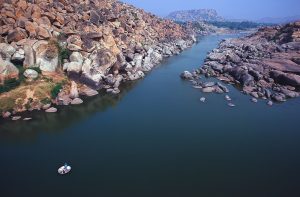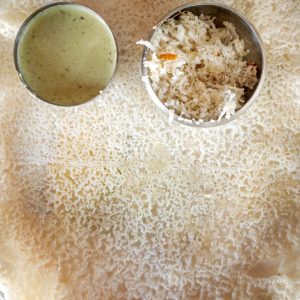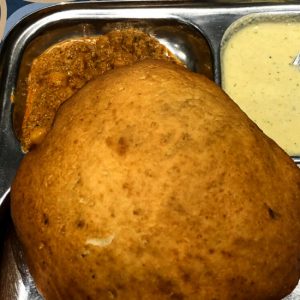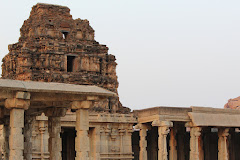Embarking on a journey to Hampi, the UNESCO World Heritage Site nestled in the heart of Karnataka, was not just a trip; it was an odyssey through the remnants of a bygone era, a rendezvous with history etched in stone, and an immersion into the vibrant culture of the region. From the awe-inspiring ruins to the local delicacies, every facet of this expedition left an indelible mark on my travel diaries.
Getting There:
My journey began with a scenic train ride from Bangalore to Hospet, the nearest railway station to Hampi. The rhythmic clickety-clack of the train wheels accompanied by glimpses of rural Karnataka set the tone for the adventure ahead. From Hospet, a short and picturesque bus ride brought me to the fabled land of Hampi.
As the bus approached, the unmistakable silhouette of the Virupaksha Temple’s towering gopuram emerged, signaling the gateway to a time-lost city. The sense of anticipation grew as I stepped off the bus, ready to traverse the enchanting ruins of Hampi.
Hotel Stay:
I opted to stay in one of the many guesthouses that offer a blend of comfort and proximity to the historical sites. The quaint streets lined with vibrant guesthouses cater to various budgets, making it accessible for all types of travelers. The rustic charm of the accommodations seamlessly complemented the historical ambiance of Hampi, offering a delightful contrast to modern city living.

Waking up to the panoramic view of boulder-strewn landscapes and the distant silhouette of ancient temples added an ethereal touch to my stay. The fusion of heritage and contemporary comforts in the lodging options made each day a perfect prelude to the adventures awaiting outside.
Local Food:


Hampi’s culinary scene is a delightful journey in itself. From humble roadside stalls to charming cafes, the town offers a diverse range of local and international cuisines. A must-try was the traditional South Indian breakfast of idlis and dosas at a local eatery, setting the stage for a day filled with energy.
The local food stalls scattered around the ruins offered quick bites like spicy mirchi bhajis (chili fritters) and piping hot chai, perfect for a recharge between exploration. One evening, I indulged in a thali at a rooftop restaurant, savoring an array of flavors that reflected the rich culinary heritage of Karnataka.
Shopping:
Hampi’s marketplaces are a treasure trove for those seeking souvenirs and local crafts. I meandered through the bustling bazaars, adorned with vibrant scarves, intricately carved stone artifacts, and the iconic Hampi-themed T-shirts.
The Hippie Island, situated across the Tungabhadra River, is a haven for bohemian enthusiasts. A boat ride took me to this serene enclave, where I explored quirky shops offering handmade jewelry, tie-dye clothing, and eclectic curios. The market’s ambiance, along with the scenic surroundings, created a shopping experience that felt like a journey into an alternative universe.
Tourist Attractions:


Hampi, often referred to as the “City of Ruins,” boasts a myriad of architectural marvels that transport visitors back in time. The Virupaksha Temple, dedicated to Lord Shiva, is a spiritual epicenter and a testament to the Vijayanagar Empire’s grandeur. The intricate carvings, towering gopurams, and the sacred vibe create an otherworldly atmosphere.
Exploring the Vitthala Temple complex was a surreal experience. The iconic Stone Chariot, musical pillars, and the grandiose architecture left me marveling at the architectural prowess of the bygone era. Each corner of Hampi seemed to conceal a story, and the ruins whispered tales of an empire that once flourished in this rocky terrain.
A climb to Matanga Hill provided a breathtaking panoramic view of the entire Hampi landscape. As the sun began its descent, the golden hues bathed the ruins in a warm glow, creating a spectacle that was both serene and awe-inspiring.
The Fun I Had:
Beyond the historical and cultural exploration, Hampi offered a myriad of activities for those seeking adventure and leisure. Bouldering enthusiasts can test their skills on the unique rock formations that dot the landscape. Hiring a bicycle and pedaling through the narrow lanes brought a sense of freedom, allowing me to absorb the town’s energy at my own pace.
One afternoon, I embarked on a coracle ride across the Tungabhadra River. The rhythmic paddling of the coracle, coupled with the gentle flow of the river, created a tranquil journey, revealing a different perspective of the Hampi ruins from the water.
Evenings in Hampi unfolded with impromptu music jam sessions at popular backpacker hostels, where travelers from around the world gathered to share stories and create an eclectic ambiance. The fusion of global cultures added a unique charm to the evenings, making them a perfect end to each day’s explorations.
Conclusion:
Hampi, with its captivating ruins, vibrant culture, and natural wonders, proved to be a kaleidoscopic adventure that transcended the realms of traditional tourism. From the architectural marvels to the culinary delights, every moment spent in this historical haven felt like a step back in time. As I bid farewell to Hampi, the memories etched in the rocks and ruins lingered, creating a tapestry of experiences that will forever hold a special place in my traveler’s heart.
By
S. Suchithra




